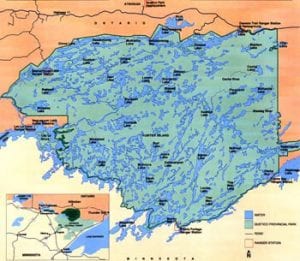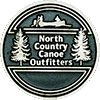NOTE: Passports are required for re-entry into the United States.

For the first time paddler, there is very little difference between the two areas. What can be found on one side of the border can also be found on the other side … good or bad. The walleye are not bigger in the BWCA, the smallmouth are not smaller. The eagles don’t fly lower, and the moose are not easier to photograph. Neither side is busier … that is far more a function of the specific entry location (see Question 13). There are entry points with quotas as high as 14 to 27 parties a day on the US side, and as high as 15 on the Canadian side. There are entry quotas as low as 1 per day on both sides. Going farther north doesn’t mean a thing. Just as one would travel south to go from Detroit, Michigan to Windsor, Ontario, so too is it possible to travel south from points in the BWCA to enter Quetico. Both sides have isolated solitude & busy areas, abundant wildlife (or the lack thereof), as well as good fishing (and sometimes, mostly due to weather, poor fishing).
Quetico Provincial Park makes up the northern half of this international canoe country. Routes in Quetico differ slightly from the U.S. side (not better and not worse). Portages and campsites are a little more rugged because the park does not have portage crew teams managing the area to specific wilderness standards as is done in the BWCA. Our experience has lead us to believe the Canadian side has slightly better lake trout fishing, while the U.S. side has slightly better walleye. Smallmouth bass and northern pike are about the same on both sides of the border. Fishing limits are smaller on the Canadian side; almost all live bait is prohibited.
The biggest difference is the per night, per person, camping fee charged to visitors of Quetico Park, versus the per trip, per person, camping fee in the BWCA. Canadian paddle-in trips (ie: not flying) require that all individuals, 18 and over, to obtain a Customs clearance 45 days in advance of the trip. The cost is CN$30, each. Youth must be listed on an attached roster form and submitted with the adults’ application.
All paddle-in canoe trips going into Quetico Park from the Ely area funnel through Prairie Portage. There are 15 parties daily. At “Prairie” you will pay your camping fees, and purchase your non-resident Ontario fishing licenses. Prairie Portage is reached by a 6-mile paddle up the Moose Lake Chain (see Moose Lake Entry in the U.S. portion of this section). Most parties reach the portage about lunch time. From here, the entry points lie in three different directions: East to Carp Lake, North to Agnes, Kahshahipiwi, and Sarah, and West to Basswood River via Basswood Lake.
Unlike the Boundary Waters Entry Points which can all be reached via a van trip or directly from our docks, Quetico Park has some entry points which are reached via float plane. These trips start on Lac La Croix Lake. There are several entry points located on these two lakes from which directional travel begins. Because a landing is made at the Canadian Customs Station on Sand Point Lake (enroute), no advance customs clearance is necessary. This cost savings can be applied towards the charter aircraft rate on your budget.
